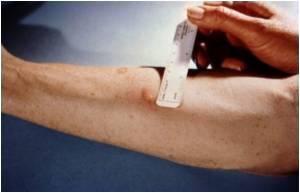Scientists have identified a molecule that allows the immune system to effectively police tuberculosis (TB) of the lungs.

"A hallmark of TB that we see on chest X-rays is the granuloma, a collection of immune cells that surround the infected lung cells," Dr. Khader said. "But what we didn't know was the difference between a functioning protective granulomae, as in latent TB, and a non-protective granuloma seen in active TB patients. We aimed to find immunologic markers that could show us the status of the infection."
For the study, which was funded by the National Institutes of Health, the researchers studied human TB-infected cells as well animal models of the disease. They found that granulomas that contain ectopic lymphoid structures, which resemble lymph nodes, are associated with effective suppression of TB, and that granulomas that don't contain them are associated with active TB. They also learned that immune cells called T cells that had a surface marker molecule called CXCR5 were associated with the presence of ectopic lymphoid structures.
It's akin to reporting a break-in, Dr. Khader said. If a person calls 911 because of a robbery, but doesn't give a specific address, the immune system police could come to the neighborhood but don't know for certain which home was invaded.
"The presence of CXCR5 provides a specific address for the infected cells that tells the immune cells where to focus their attention to contain the problem," she explained. "That results in the formation of ectopic lymphoid structures and the protective granuloma that keeps TB infection under control, unlike in active disease. Without CXCR5, those structures did not form and active TB was more likely."
When the researchers delivered CXCR5 T cells from donor animals to TB-infected mice that lacked CXCR5, T cell localization and ectopic lymphoid structure formation was restored, leading to decreased susceptibility to TB.
Advertisement
Source-Eurekalert















